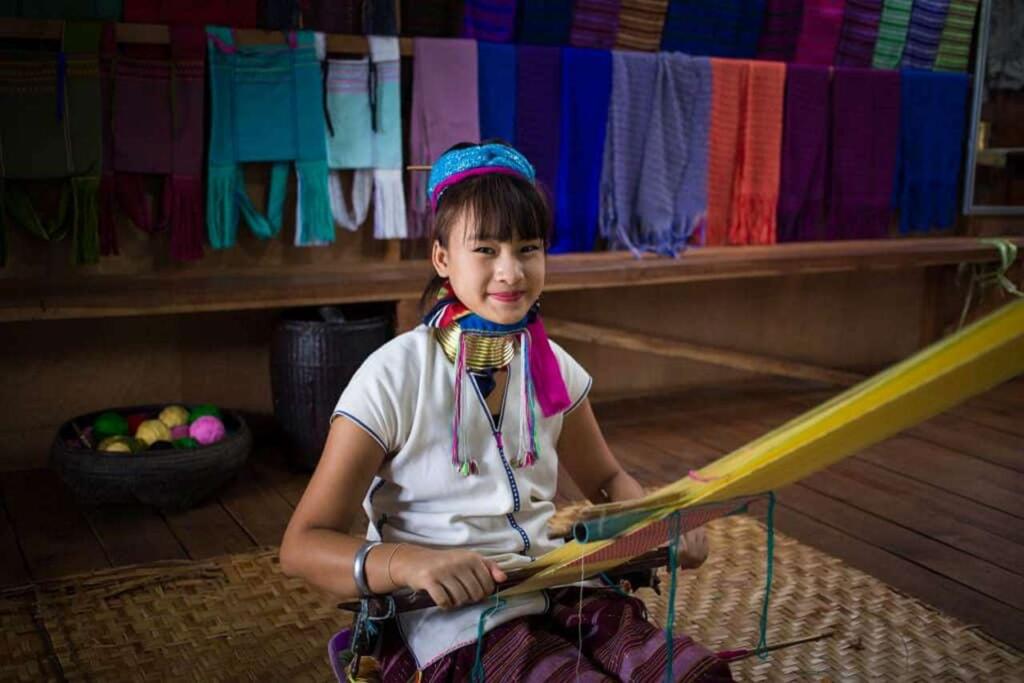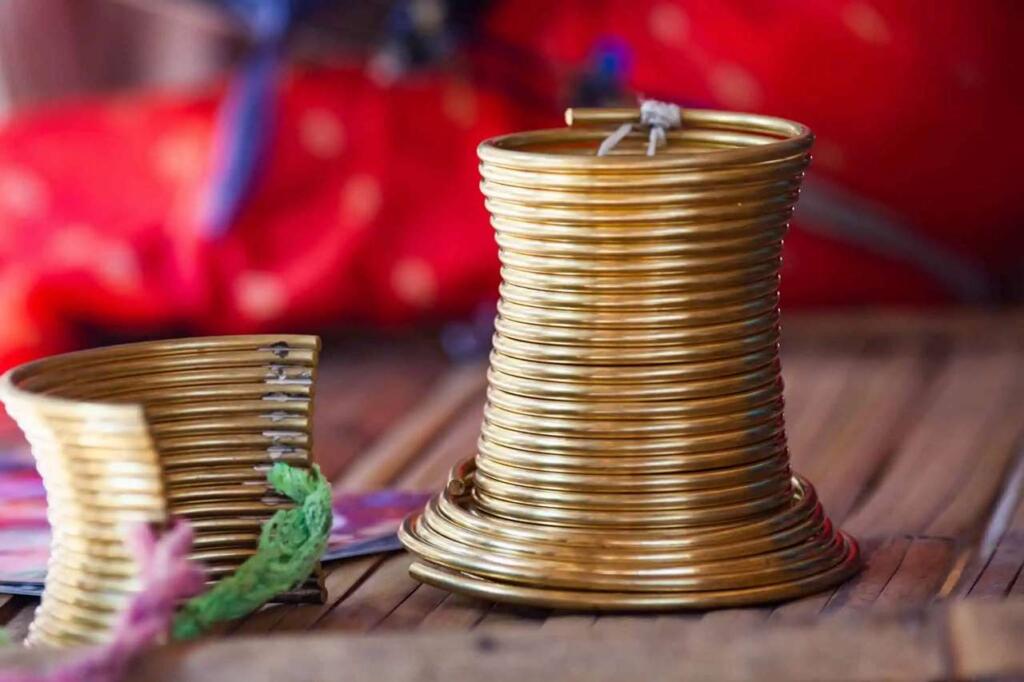Imagine a world where necks stretch to extraordinary lengths, resembling the graceful elegance of a giraffe.
In certain cultures, this image becomes a reality through the practice of wearing neck rings. This article delves into the intriguing phenomenon of ‘Giraffe Woman: The Longest Neck in the World.’
Exploring the origins of neck rings, we will uncover their significance among different tribes, particularly the Kayan women of Myanmar and the Ndebele tribe. These women adorn themselves with neck rings as symbols of beauty, status, and cultural heritage.
However, behind this exotic adornment lies an array of health issues that accompany elongated necks. By understanding both the cultural significance and potential risks associated with this practice, we gain insight into these unique individuals who proudly wear their extended necks as a testament to tradition and identity.
Join us on this journey as we immerse ourselves in a world where extraordinary necks become an embodiment of beauty and culture.
Key Takeaways
- Neck rings have been worn by certain cultures for centuries as symbols of beauty, status, and cultural heritage.
- The practice of wearing neck rings can be traced back to the 11th century in Asia, with Kayan women being known as ‘giraffe women’ due to their long necks.
- Wearing neck rings can pose health risks, including difficulty in functioning independently and potential suffocation if removed after long-term use.
- Despite the health risks, Kayan women and Ndebele tribe members continue to wear neck rings as a testament to tradition and cultural identity.

Origin of the Neck Rings
The origin of the neck rings worn by Kayan women and the Ndebele tribe remains shrouded in mystery, with theories ranging from protection to symbolism, adding an air of intrigue and curiosity to these ancient traditions.
The practice of wearing neck rings can be traced back to the 11th century in Asia, where Celtic people also wore them for different reasons. However, it is among the Kayan women of Myanmar that this tradition has been preserved for centuries.
For Kayan women, the process of wearing neck rings begins at a young age and they rarely remove them throughout their lives. They are often referred to as ‘giraffe women’ due to their long necks, which have earned them a place in the Guinness Book of World Records for having the longest necks in the world. While there are various theories regarding the purpose behind wearing these neck coils, ranging from protection against tiger attacks to symbolizing beauty and wealth, none can be definitively proven.
On the other hand, Ndebele women wear neck rings as a status symbol. The number of rings indicates their husband’s wealth and social standing within the community. Interestingly, Ndebele women have the option to remove their neck rings after their husband’s death.
It is important to note that while these traditions have endured over time, wearing neck rings does pose health risks due to compression on collarbones and ribcage. Sydney Smith, known as a self-proclaimed giraffe woman who wore neck rings for five years, had difficulties functioning independently and ultimately removed them. For Kayan women who have worn these coils all their lives, removing them could potentially lead to suffocation due to changes in bone structure caused by long-term use.
Despite these health risks associated with wearing neck rings, both Kayan and Ndebele women have safely worn them thanks to tradition and experience passed down through generations. It is crucial to recognize that these traditions are deeply rooted in cultural significance and should be respected as such.
Tribes with Neck Rings
This discussion focuses on two tribes known for wearing neck rings: the Kayan women of Myanmar and the Ndebele tribe of Africa.
The Kayan women have been wearing neck rings for centuries, starting at a young age and rarely removing them. They are often referred to as ‘giraffe women’ due to their long necks and hold the record for having the longest necks in the world.
On the other hand, the Ndebele women wear neck rings as a status symbol, with the number of rings indicating their husband’s wealth.
Kayan Women of Myanmar
Originating from Myanmar, Kayan women have been wearing neck rings for centuries, creating an illusion of elongated necks. The practice of wearing these neck rings is deeply rooted in their culture and has become a defining feature for them. While the purpose of wearing these rings is still uncertain, theories range from protection to symbolism. These brass coils are often added gradually over time, starting at a young age and rarely being removed. By compressing the collarbones and ribcage, the neck appears longer than it actually is.
This traditional practice has gained attention worldwide due to its unique appearance and cultural significance. However, it is important to note that wearing neck rings can pose health risks, such as difficulty in functioning independently. Despite these challenges, Kayan women continue to embrace their cultural heritage through this ancient tradition.
| Pros | Cons |
|---|---|
| Symbolizes cultural identity | Health risks associated with prolonged wear |
| Creates sense of community among Kayan women | Limited opportunities for education and career due to refugee status |
| Attracts tourism which boosts local economy | Challenges faced as refugees escaping military regime in Myanmar |
| Preserves traditional practices and knowledge | Uncertainty surrounding the purpose of neck rings |
Table: Pros and Cons of Kayan Women Wearing Neck Rings

Ndebele Tribe of Africa
Indigenous to Africa, the Ndebele tribe practices the custom of adorning neck rings as a means of showcasing their husband’s wealth through the number of coils worn.
Unlike the Kayan women of Myanmar who wear neck rings for uncertain reasons, the Ndebele women use them as status symbols.
The more neck rings a woman wears, the higher her husband’s perceived wealth and social standing.
Interestingly, the ability to remove these neck rings is also unique to the Ndebele culture.
Upon her husband’s death, a woman can choose to remove her neck rings as a symbol of mourning and freedom from marital obligations.
The origins of the Ndebele tribe remain unknown, but their tradition of wearing neck rings has persisted throughout generations.
This custom adds cultural richness and diversity to Africa’s heritage.

Giraffe Woman With The Longest Neck in the World
Sydney Smith, a self-proclaimed giraffe woman who wore neck rings for five years before removing them due to difficulties, highlighted the challenges and health risks associated with wearing neck rings.
Neck rings, also known as neck coils or neck elongation devices, have been worn by various cultures throughout history. The practice of wearing neck rings can be traced back to the 11th century in Asia, where Celtic people also utilized them for different reasons.
The Kayan women of Myanmar, also known as the ‘giraffe women,’ are well-known for their long necks achieved through the use of these rings. Starting at a young age, Kayan women wear these coils and rarely remove them. The purpose behind this tradition remains uncertain, with theories ranging from protection to symbolism.
While some may find this practice intriguing, it is important to note that wearing neck rings can have adverse effects on one’s health. These include difficulty in functioning independently and potential suffocation if the rings are removed after being worn for an extended period. However, it is crucial to acknowledge that both Kayan women and Ndebele tribe members have safely worn these rings thanks to their long-standing traditions and experience.
Sydney Smith’s experience sheds light on the challenges faced by those who choose to wear neck rings. It is essential to understand that while this practice may be culturally significant for certain communities like the Kayan women and Ndebele tribe members, it comes with its share of health risks that should not be overlooked.
Health Issues of Wearing Neck Rings
One of the major concerns regarding the practice of wearing neck rings is the potential health issues associated with this tradition. Wearing neck rings can have detrimental effects on a person’s health due to the compression and displacement of body structures.
The neck coils, made from brass or copper, exert pressure on the collarbones and ribcage, creating an illusion of a longer neck. However, this compression can lead to various health problems.
Firstly, wearing neck rings can cause difficulty in functioning independently. The constant pressure on the collarbones and ribcage restricts movement and flexibility, making simple tasks such as turning the head or lifting objects challenging.
Additionally, long-term wear of neck rings may result in muscular atrophy and weakness in the surrounding areas. The continuous compression hinders proper blood circulation and muscle development, leading to reduced strength and functionality.
Furthermore, there is a risk of suffocation if Kayan women who have worn neck rings all their lives decide to remove them. The prolonged use of these coils causes adaptations in the body structure that make it difficult for individuals to breathe properly without them.
It is important to note that while some women like Sydney Smith have chosen to remove their neck rings after experiencing difficulties, others who have worn them for their entire lives may face severe health consequences if they choose to do so.
Overall, despite being a traditional practice for centuries among certain cultures like the Kayan women and Ndebele tribe, wearing neck rings poses significant health risks due to compression-related issues.

Cultural Significance
The cultural significance surrounding the practice of wearing neck rings lies in its deep-rooted history and symbolism within certain communities. This tradition has been passed down through generations, with the Kayan women of Myanmar and the Ndebele tribe being notable examples.
The cultural significance of neck rings can be understood through the following aspects:
1) Symbolism: Neck rings are often seen as a symbol of beauty, femininity, and cultural identity. They represent a connection to one’s heritage and serve as a form of self-expression.
2) Status and Wealth: In some societies, such as the Ndebele tribe, neck rings are indicative of a woman’s husband’s wealth and social status. The number of neck rings worn by a woman reflects her husband’s ability to provide for her.
3) Community Identity: For the Kayan women, wearing neck rings is not only a personal choice but also an important aspect of their community identity. It distinguishes them from other ethnic groups and serves as a unifying symbol among their own people.
It is important to note that while these cultures have embraced this tradition for centuries, there are potential health risks associated with wearing neck rings. Understanding the cultural significance behind this practice helps us appreciate its importance within these communities while also acknowledging the need for safety precautions and informed decision-making regarding personal health.
Conclusion
In conclusion, the tradition of wearing neck rings in certain cultures holds a significant cultural and symbolic value, highlighting aspects such as beauty, femininity, wealth, and community identity. However, it is important to recognize the potential health risks associated with this practice and promote informed decision-making regarding personal well-being.
The table below summarizes the key points discussed throughout this article:
| Tradition | Kayan Women | Ndebele Women |
|---|---|---|
| Origin | Myanmar | Unknown |
| Age to Start | Young age | Not specified |
| Removal | Rarely | After husband’s death |
| Symbolism/Function | Uncertain – theories range from protection to symbolism | Status symbol – number of rings indicates husband’s wealth |
The practice of wearing neck rings has been a part of the Kayan culture for centuries and is often associated with their identity as “giraffe women.” The Guinness Book of World Records recognizes Kayan women for having the longest necks in the world. In contrast, Ndebele women wear neck rings primarily as a status symbol, representing their husband’s wealth.
It is worth noting that wearing neck rings can have adverse effects on physical health. The compression caused by these coils on collarbones and ribcage can lead to difficulties in functioning independently. While some individuals have safely worn neck rings due to tradition and experience, it is essential to acknowledge that removing them after prolonged use may pose serious risks, including suffocation.
Overall, understanding the cultural significance of wearing neck rings provides valuable insights into these unique traditions; however, prioritizing individual well-being through informed decision-making should be encouraged to ensure overall health and safety.
Frequently Asked Questions
How do Kayan women and the Ndebele tribe wear neck rings safely without experiencing health issues?
Kayan women and the Ndebele tribe wear neck rings safely by following long-standing traditions and gaining experience. The neck coils compress collarbones and ribcage, creating an illusion of a longer neck, but wearing them for extended periods can lead to health issues.
What are the different theories about the purpose of neck rings for Kayan women?
One theory about the purpose of neck rings for Kayan women is that they serve as a symbol of beauty and femininity. Another theory suggests that the rings provide protection against evil spirits and wild animals.
How do neck rings create the illusion of a longer neck?
Neck rings create the illusion of a longer neck by compressing the collarbones and ribcage. This compression allows the neck to appear elongated, giving the impression of a longer neck without actually increasing its length.
What challenges do the Kayan people face as refugees, and how do these challenges affect their opportunities for education and career?
The challenges faced by the Kayan people as refugees, such as limited opportunities for education and career, greatly impact their future prospects. These obstacles act as roadblocks on their path to personal growth and success.
Why did Sydney Smith, the self-proclaimed giraffe woman, decide to remove her neck rings after wearing them for 5 years?
Sydney Smith, the self-proclaimed giraffe woman, decided to remove her neck rings after wearing them for 5 years due to difficulties she encountered. These difficulties may include health issues and challenges in functioning independently.
Conclusion
The practice of wearing neck rings among the Kayan women of Myanmar and the Ndebele tribe has a long history and cultural significance.
The purpose of wearing these neck rings is still uncertain, with theories ranging from protection to symbolism.
Despite the potential health risks and challenges faced by these communities as refugees, both the Kayan and Ndebele women have safely worn neck rings for centuries.
One interesting statistic is that the Guinness Book of World Records introduced the category of longest neck rings in 2018, highlighting the uniqueness and fascination surrounding this tradition.

















